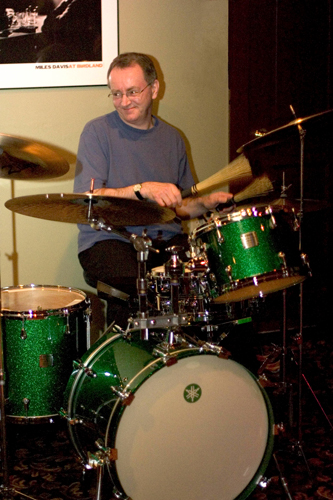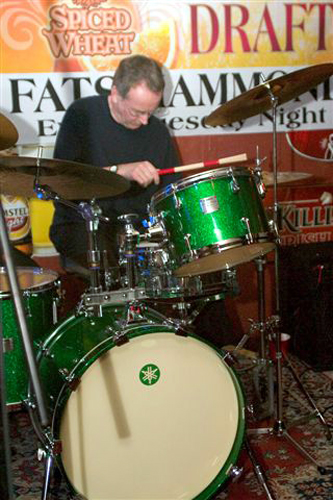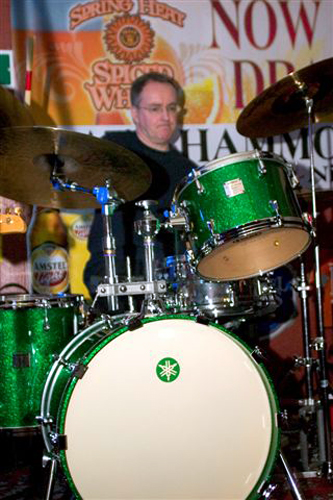TECH' PAGE # 5 / MAY '06
_______________________
The "Gigging" Kit.
 |
|
Photo: Jim Primmer
|
For those of you who come to see me play around the New England area in various clubs/smaller venues, you've probaly noticed a new set. I thought I'd detail it here - with pictures - & elaborate on it's spec', the tuning employed & also the cymbal selection. You may have seen pictures of another kit on the "Gigs" page ; a red-ish "9000" birch set but with seperate lugs. This was one of the first Yamaha sets I got in the UK [early '80's] & subsequently had it shipped to the US when we moved here in 2000. This is really configured more for studio use [with a lower tuning] ; as wonderful as it sounds, it's not set up/practical for non-mic'd gigs. Enter the green kit! I'll describe the set first , then go to tuning & cymbal choice.
 |
|
Photo: Jim Primmer
|
If you've read these pages before, you know I'm not a fan of "long" drums, so I ordered [what I'm now bemused to learn are] "special" sizes. On this Maple Custom Absolute set, the BD is 20" x 14", the rack tom is 12" x 8" & the floor tom is 14" x 14". I guess it's down to what's comfortable for you - those are the sizes I started with & a 20" x 18" bass drum, for example, has never been my thing. I sent a swatch of a piece of green sparkle to Yamaha, they faithfully copied the colour & did a sensational job - yes, that's a paint finish! I chose the Nouveau lugs not so much for the convenient quick-head-release facility [in my case, head changes are maybe once a year!] but for the minimal hardware-to-shell contact which allows for maximum shell resonance. Yamaha's "yess" tom-holder system helps the resonance too & due to their excellent hardware options, it was easy to mount the ride cymbal off of the rack tom mount. Snare Drum is typically the brass one detailed on a previous Tech' page, though I do change it from time to time.
Evans head choice is a clear EMAD [utilising only half of the thinner foam ring] on the BD, & G2 clears on the top of the toms; clear & coated G1's under the 12" & 14" toms respectively. The BD is wide open, fyi. The tuning employed is fairly high on all three drums, with a very slightly lower tension on all batter heads. Although the sound is almost "bop-ish" behind the set, all three project beautifully & using the thicker G2 on the toms prevents them heading toward a "jazz" sound that one would typically get using a regular coated G1 as a batter.
 |
|
Photo: Jim Primmer
|
I do change & swop my Zildjian cymbals now & again, sometimes depending on venues, but I've recently settled on a combination that works well with this set.
The ride [it makes a great crash too - what a concept !] is a 20" Constantinople high bell which I've put two brass rivets in...you can dig-in to this without it overpowering things. The crash is one of the new 17" Hybrids ; I sometimes swop this for a 17" Session crash [proto-type] - the former is just a little tougher sounding but without getting "clang-y" the way some heavier cymbals can. The Chinese on my far right is a 17" K ; it's a very thin one I've had for a long time - I hope to find something close to it on my next Zildjian visit as I'm getting a little concerned for it's health! The hi-hats are a pair of 13" K's ; the bottom is from their "Dry" series , the top a Constantinople. I have an ancient pair of K's from the 50's - with a very dry sounding bottom cymbal - & that was the idea behind putting that combination together. Kudos is due to the wonderful John King @ Z for helping me do that.
Regarding the choice/selection of those cymbals & in particular the drum tuning: the really pertinent factor here [which I became aware of a long time ago, but its relevance has become more important to me] is the extent to which sound changes the further you get away from the source. Basically, percieved pitch drops as you move away from it - I always use the "train passing through the station/crossing" analogy when describing this to students. One of the most difficult aspects of tuning & cymbal selection - especially for "live" work - is coming to terms with the difference between how the drums & cymbals sound when sitting behind the set & how they sound 6, 12, or even 40 foot away. This difference is magnified when microphones are not employed. Your set with the pinstripes on the groovy low-tuned toms probably sound like baby's arms hitting pillows by the time they reach the back of the club - particularly if [1] your band is loud & [2] you're not mic'd. I sometimes have a drummer friend sit-in on a gig ; as well as getting to hear that person play, it's also useful to hear how the set sounds when you're not on top of it. In that situation it's also important to dial-in that players' touch too.
I hope this has been of interest to you - to re-iterate, don't hesitate to contact me if you've queries & I'll do my best to answer them. Better still, come & see me play &/or have a lesson!
Keep up the good work!
DM



